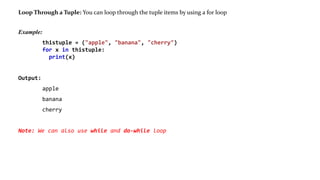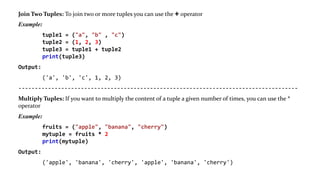Tuple in python
- 1. TUPLES
- 2. Tuples: Like list, Tuples are used to store multiple items in a single variable. A tuple is a collection which is ordered and unchangeable. Tuples are written with round brackets. Example: thistuple = ("apple", "banana", "cherry") print(thistuple) Output: ("apple", "banana", "cherry") Tuple items are indexed, the first item has index [0], the second item has index [1] etc.
- 3. Sl. No. Key List Tuple 1 Type List is mutable. Tuple is immutable. 2 Iteration List iteration is slower and is time consuming. Tuple iteration is faster. 3 Appropriate for List is useful for insertion and deletion operations. Tuple is useful for read only operations like accessing elements. 4 Memory Consumption List consumes more memory. Tuples consumes less memory. 5 Methods List provides many in-built methods. Tuples have less in-built methods. 6 Error prone List operations are more error prone. Tuples operations are safe. Following are the important differences between List and Tuple.
- 4. Similarities: Although there are many differences between list and tuple, there are some similarities too, as follows: • The two data structures are both sequence data types that store collections of items. • Items of any data type can be stored in them. • Items can be accessed by their index. Difference in syntax As mentioned in the introduction, the syntax for list and tuple are different. For example: list_num = [10, 20, 30, 40] tup_num = (10, 20, 30, 40)
- 5. Allow Duplicates: Since tuples are indexed, they can have items with the same value: Example: thistuple = ("apple", "banana", "cherry", "apple", "cherry") print(thistuple) Output: ('apple', 'banana', 'cherry', 'apple', 'cherry')
- 6. Tuple Length: To determine how many items a tuple has, use the len() function Example: thistuple = ("apple", "banana", "cherry") print(len(thistuple)) Output: 3
- 7. Create Tuple With One Item: To create a tuple with only one item, you have to add a comma after the item, otherwise Python will not recognize it as a tuple. Example: thistuple = ("apple",) print(type(thistuple)) #NOT a tuple thistuple = ("apple") print(type(thistuple)) Output: <class 'tuple'> <class 'str'>
- 8. Tuple Items - Data Types: Tuple items can be of any data type Example: tuple1 = ("apple", "banana", "cherry") tuple2 = (1, 5, 7, 9, 3) tuple3 = (True, False, False) print(tuple1) print(tuple2) print(tuple3) Output: ('apple', 'banana', 'cherry') (1, 5, 7, 9, 3) (True, False, False)
- 9. Tuple Items - Data Types (C0ntinue): A tuple can contain different data types Example: tuple1 = ("abc", 34, True, 40, "male") print(tuple1) Output: ('abc', 34, True, 40, 'male')
- 10. type(): From Python's perspective, tuples are defined as objects with the data type 'tuple' <class 'tuple'> Example: mytuple = ("apple", "banana", "cherry") print(type(mytuple)) Output: <class 'tuple'>
- 11. The tuple() Constructor: It is also possible to use the tuple() constructor to make a tuple. Example: thistuple = tuple(("apple", "banana", "cherry")) # note the double round-brackets print(thistuple) Output: ('apple', 'banana', 'cherry')
- 12. Access Tuple Items: You can access tuple items by referring to the index number, inside square brackets Example: thistuple = ("apple", "banana", "cherry") print(thistuple[1]) Output: banana -------------------------------------------------------------------------------------- -------------------------------------------------------------------------------------- Negative Indexing: Negative indexing means start from the end. -1 refers to the last item, -2 refers to the second last item etc. Example: thistuple = ("apple", "banana", "cherry") print(thistuple[-1]) Output: cherry
- 13. Range of Indexes: You can specify a range of indexes by specifying where to start and where to end the range. When specifying a range, the return value will be a new tuple with the specified items. Example: thistuple = ("apple", "banana", "cherry", "orange", "kiwi", "melon", "mango") print(thistuple[2:5]) Output: ('cherry', 'orange', 'kiwi') Note: The search will start at index 2 (included) and end at index 5 (not included). ------------------------------------------------------------------------------------------------------------------------------------------ Example: thistuple = ("apple", "banana", "cherry", "orange", "kiwi", "melon", "mango") print(thistuple[:4]) Output: ('apple', 'banana', 'cherry', 'orange')
- 14. Guess the output: Example: thistuple = ("apple", "banana", "cherry", "orange", "kiwi", "melon", "mango") print(thistuple[2:]) Output: ? -------------------------------------------------------------------------------------- Range of Negative Indexes: Specify negative indexes if you want to start the search from the end of the tuple Example: thistuple = ("apple", "banana", "cherry", "orange", "kiwi", "melon", "mango") print(thistuple[-4:-1]) Output: ('orange', 'kiwi', 'melon')
- 15. Change Tuple Values: Once a tuple is created, you cannot change its values - unchangeable or immutable. But there is a workaround. You can convert the tuple into a list, change the list, and convert the list back into a tuple. Example: x = ("apple", "banana", "cherry") y = list(x) y[1] = "kiwi" x = tuple(y) print(x) Output: ("apple", "kiwi", "cherry")
- 16. Add Items: Since tuples are immutable, they do not have a build-in append() method, but there are other ways to add items to a tuple. 1. Convert into a list: Just like the workaround for changing a tuple, you can convert it into a list, add your item(s), and convert it back into a tuple. Example: thistuple = ("apple", "banana", "cherry") y = list(thistuple) y.append("orange") thistuple = tuple(y)Output: ("apple", "kiwi", "cherry") Output: ('apple', 'banana', 'cherry', 'orange')
- 17. Add Items(continue): 2. Add tuple to a tuple: You are allowed to add tuples to tuples, so if you want to add one item, (or many), create a new tuple with the item(s), and add it to the existing tuple Example: thistuple = ("apple", "banana", "cherry") y = ("orange",) thistuple += y print(thistuple) Output: ('apple', 'banana', 'cherry', 'orange')
- 18. Remove Items: Tuples are unchangeable, so you cannot remove items from it, but you can use the same workaround as we used for changing and adding tuple items Example: thistuple = ("apple", "banana", "cherry") y = list(thistuple) y.remove("apple") thistuple = tuple(y) Output: ('banana', 'cherry') ------------------------------------------------------------------------------------- Example: thistuple = ("apple", "banana", "cherry") del thistuple print(thistuple) #this will raise an error because the tuple no longer exists Output: NameError: name 'thistuple' is not defined
- 19. Unpacking a Tuple: When we create a tuple, we normally assign values to it. This is called "packing" a tuple Example: fruits = ("apple", "banana", "cherry") Output: ('apple', 'banana', 'cherry') ------------------------------------------------------------------------------------- But, in Python, we are also allowed to extract the values back into variables. This is called "unpacking": Example: fruits = ("apple", "banana", "cherry") (green, yellow, red) = fruits print(green) print(yellow) print(red) Output: apple banana cherry
- 20. Unpacking a Tuple: When we create a tuple, we normally assign values to it. This is called "packing" a tuple Example: fruits = ("apple", "banana", "cherry") Output: ('apple', 'banana', 'cherry') ------------------------------------------------------------------------------------- But, in Python, we are also allowed to extract the values back into variables. This is called "unpacking": Example: fruits = ("apple", "banana", "cherry") (green, yellow, red) = fruits print(green) print(yellow) print(red) Output: apple banana cherry Note: The number of variables must match the number of values in the tuple, if not, you must use an * asterisk to collect the remaining values as a list.
- 21. Using Asterisk * : If the number of variables is less than the number of values, you can add an * to the variable name and the values will be assigned to the variable as a list Example: fruits = ("apple", "banana", "cherry", "strawberry", "raspberry") (green, yellow, *red) = fruits print(green) print(yellow) print(red) Output: apple banana ['cherry', 'strawberry', 'raspberry']
- 22. Using Asterisk * (continue): Example: fruits = ("apple", "mango", "papaya", "pineapple", "cherry") (green, *tropic, red) = fruits print(green) print(tropic) print(red) Output: apple ['mango', 'papaya', 'pineapple'] cherry
- 23. Loop Through a Tuple: You can loop through the tuple items by using a for loop Example: thistuple = ("apple", "banana", "cherry") for x in thistuple: print(x) Output: apple banana cherry Note: We can also use while and do-while loop
- 24. Join Two Tuples: To join two or more tuples you can use the + operator Example: tuple1 = ("a", "b" , "c") tuple2 = (1, 2, 3) tuple3 = tuple1 + tuple2 print(tuple3) Output: ('a', 'b', 'c', 1, 2, 3) ------------------------------------------------------------------------------------- Multiply Tuples: If you want to multiply the content of a tuple a given number of times, you can use the * operator Example: fruits = ("apple", "banana", "cherry") mytuple = fruits * 2 print(mytuple) Output: ('apple', 'banana', 'cherry', 'apple', 'banana', 'cherry')


![Tuples:
Like list, Tuples are used to store multiple items in a single variable.
A tuple is a collection which is ordered and unchangeable.
Tuples are written with round brackets.
Example:
thistuple = ("apple", "banana", "cherry")
print(thistuple)
Output:
("apple", "banana", "cherry")
Tuple items are indexed, the first item has index [0], the second item has index [1] etc.](https://image.slidesharecdn.com/tuple-220211112901/85/Tuple-in-python-2-320.jpg)

![Similarities:
Although there are many differences between list and tuple, there are some
similarities too, as follows:
• The two data structures are both sequence data types that store collections of
items.
• Items of any data type can be stored in them.
• Items can be accessed by their index.
Difference in syntax
As mentioned in the introduction, the syntax for list and tuple are different.
For example:
list_num = [10, 20, 30, 40]
tup_num = (10, 20, 30, 40)](https://image.slidesharecdn.com/tuple-220211112901/85/Tuple-in-python-4-320.jpg)
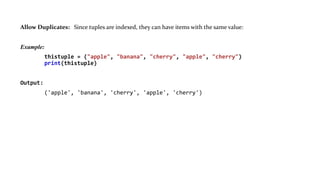
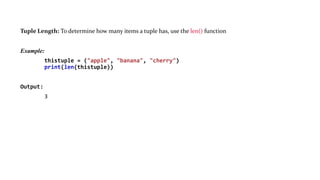


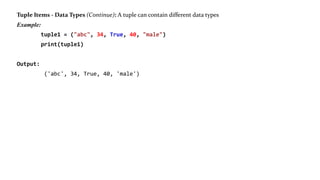


![Access Tuple Items: You can access tuple items by referring to the index number, inside square brackets
Example:
thistuple = ("apple", "banana", "cherry")
print(thistuple[1])
Output:
banana
--------------------------------------------------------------------------------------
--------------------------------------------------------------------------------------
Negative Indexing: Negative indexing means start from the end. -1 refers to the last item, -2 refers to the
second last item etc.
Example:
thistuple = ("apple", "banana", "cherry")
print(thistuple[-1])
Output:
cherry](https://image.slidesharecdn.com/tuple-220211112901/85/Tuple-in-python-12-320.jpg)
![Range of Indexes: You can specify a range of indexes by specifying where to start and where to end the range.
When specifying a range, the return value will be a new tuple with the specified items.
Example:
thistuple = ("apple", "banana", "cherry", "orange", "kiwi", "melon", "mango")
print(thistuple[2:5])
Output:
('cherry', 'orange', 'kiwi')
Note: The search will start at index 2 (included) and end at index 5 (not included).
------------------------------------------------------------------------------------------------------------------------------------------
Example:
thistuple = ("apple", "banana", "cherry", "orange", "kiwi", "melon", "mango")
print(thistuple[:4])
Output:
('apple', 'banana', 'cherry', 'orange')](https://image.slidesharecdn.com/tuple-220211112901/85/Tuple-in-python-13-320.jpg)
![Guess the output:
Example:
thistuple = ("apple", "banana", "cherry", "orange", "kiwi", "melon", "mango")
print(thistuple[2:])
Output:
?
--------------------------------------------------------------------------------------
Range of Negative Indexes: Specify negative indexes if you want to start the search from the end of the tuple
Example:
thistuple = ("apple", "banana", "cherry", "orange", "kiwi", "melon", "mango")
print(thistuple[-4:-1])
Output:
('orange', 'kiwi', 'melon')](https://image.slidesharecdn.com/tuple-220211112901/85/Tuple-in-python-14-320.jpg)
![Change Tuple Values: Once a tuple is created, you cannot change its values - unchangeable or immutable.
But there is a workaround. You can convert the tuple into a list, change the list, and convert the list
back into a tuple.
Example:
x = ("apple", "banana", "cherry")
y = list(x)
y[1] = "kiwi"
x = tuple(y)
print(x)
Output:
("apple", "kiwi", "cherry")](https://image.slidesharecdn.com/tuple-220211112901/85/Tuple-in-python-15-320.jpg)
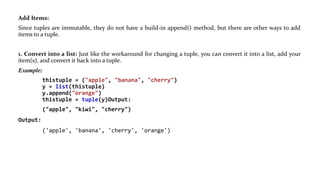



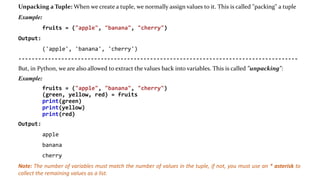
![Using Asterisk * : If the number of variables is less than the number of values, you can add an * to the
variable name and the values will be assigned to the variable as a list
Example:
fruits = ("apple", "banana", "cherry", "strawberry", "raspberry")
(green, yellow, *red) = fruits
print(green)
print(yellow)
print(red)
Output:
apple
banana
['cherry', 'strawberry', 'raspberry']](https://image.slidesharecdn.com/tuple-220211112901/85/Tuple-in-python-21-320.jpg)
![Using Asterisk * (continue):
Example:
fruits = ("apple", "mango", "papaya", "pineapple", "cherry")
(green, *tropic, red) = fruits
print(green)
print(tropic)
print(red)
Output:
apple
['mango', 'papaya', 'pineapple']
cherry](https://image.slidesharecdn.com/tuple-220211112901/85/Tuple-in-python-22-320.jpg)
